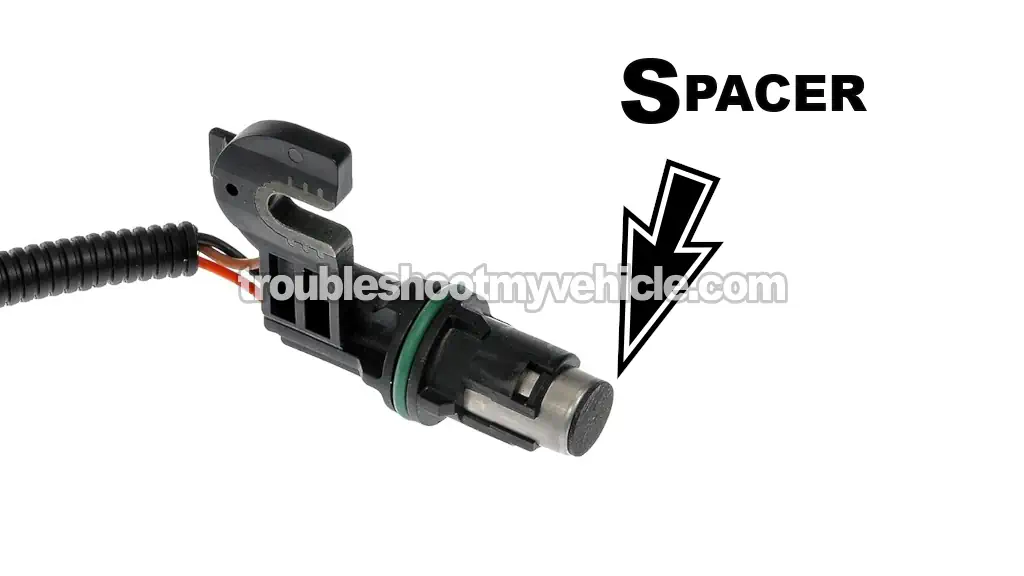TEST 2: Making Sure The CMP Sensor Is Getting 5 Volts

If the CMP sensor isn't putting out an ON/OFF voltage signal, the next step is to check whether the PCM is supplying it with the correct 5 Volt reference signal.
This voltage should be present at terminal #1 of the connector — which connects to the pink with yellow stripe (PNK/YEL) wire. We'll check for voltage with the ignition key in the RUN position (engine off).
This only takes a minute, but it's a critical check. If the 5 Volts aren't there, the sensor can't operate — so don't skip this before moving forward.
Alright, here's what to do:
- 1
Unplug the CMP sensor connector.
- 2
Attach the black meter lead to the battery's negative (-) terminal.
- 3
Turn the ignition key to the ON position, but don't crank the engine.
- 4
Set your multimeter to measure DC Volts.
- 5
Use the red meter lead to probe terminal 1 at the connector.
NOTE: Make sure terminal 1 connects to the PNK/YEL wire before testing. - 6
You should see around 4.5 to 5 Volts DC on your meter.
Here's what your results mean:
CASE 1: You get 4.5 to 5 Volts. That's exactly what you want —it means the PCM is sending the correct power to the sensor.
Now it's time to confirm the CMP sensor is getting a good Ground. Continue to: TEST 3: Making Sure The CMP Sensor Is Getting Ground.
CASE 2: No voltage present. Recheck your setup and try again.
If there's still no voltage, it likely means there's an open in the PNK/YEL wire between the PCM and the sensor —you'll need to track down and fix the break in the circuit to restore power and get the sensor working again.
TEST 3: Making Sure The CMP Sensor Is Getting Ground

At this point, if you've completed the first two tests, you've verified the following:
- TEST 1: The CMP sensor isn't generating the expected ON/OFF voltage signal.
- TEST 2: The sensor is receiving its 5 Volt power supply.
The last check we need to make is for a good Ground connection on the dark blue with dark green stripe (DK BLU/DK GRN) wire at the CMP sensor connector.
This DK BLU/DK GRN wire is connected to terminal 2, as shown in the pinout illustration above.
IMPORTANT: This Ground circuit is provided directly by the PCM —never apply battery voltage to this wire. Doing so will instantly fry the PCM. We'll safely test it by doing a simple voltage test using our multimeter.
Here's how to test the CMP sensor's Ground circuit:
- 1
Unplug the CMP sensor.
- 2
Connect the red meter lead to the battery's positive (+) terminal.
- 3
Switch the ignition to the ON position (don't crank the engine).
- 4
Set the multimeter to measure DC Volts.
- 5
Use the black meter lead to probe terminal #2.
NOTE: Be sure this is the terminal connected to the DK BLU/DK GRN wire. - 6
You should see a voltage reading between 10 and 12 Volts if the Ground circuit is intact.
Here's what the results mean:
CASE 1: You read 10–12 Volts. That's great —the sensor is properly Grounded.
So if the sensor had power (TEST 2) but failed to output a signal (TEST 1), then it's internally faulty and needs to be replaced.
Be sure and take a look at: Installing The CMP Sensor: Air Gap Clearance.
CASE 2: No voltage shows up. Make sure your leads are connected correctly and retest.
If you still get zero Volts, the Ground wire likely has an open —meaning it's broken somewhere between the connector and the PCM. Without a good Ground, the CMP sensor won't function, and the fault lies in the wiring.
Your next move is to trace and repair the Ground issue in the DK BLU/DK GRN wire to restore proper sensor operation.
Installing The CMP Sensor: Air Gap Clearance

For the CMP sensor to work properly —and to avoid contact with the camshaft gear— it needs a precise air gap of about 0.020 inches (0.5 mm).
This clearance is set by a thin paper spacer that comes pre-installed on the sensor's tip.
New sensors include this spacer out of the box, and it's important not to remove it. That little strip ensures the sensor sits at the correct distance once mounted to the timing cover.
Don't be tempted to peel it off —if the sensor ends up too close to the cam gear, it can get damaged the second you turn the key.
If the spacer's missing —which often happens when reusing the sensor, since the cam gear tends to shave it off— you can make your own replacement using an index card.
Just cut out small discs, stack and glue them until you reach 0.020 inches (0.5 mm) thick. This will give you the right clearance and let you torque the sensor into place without any guesswork.
Prefer to skip the DIY route? You can order a replacement spacer online here:
- Walker Products 235-1378 CMP Sensor Spacer (at: amazon.com).
More 3.3L V6 Chrysler, Dodge, And Plymouth Minivan Tutorials
You can find a complete list of 3.3L V6 Chrysler, Dodge, and Plymouth minivan tutorials in this index:
Here's a small sample of the tutorials you'll find in the index:
- P0171 Diagnostics (1996-2010 3.3L V6 Chrysler, Dodge, And Plymouth Minivan).
- P0420 Diagnostics -Catalytic Converter Tests (1996-2010 3.3L V6 Chrysler, Dodge And Plymouth Minivan).
- How To Check For Vacuum Leaks: Carb Cleaner Spray (1991-2010 3.9L V6 Chrysler, Dodge, And Plymouth Minivan).
- How To Test For A Blown Head Gasket (1991-2010 3.3L V6 Chrysler, Dodge, And Plymouth Minivan).

If this info saved the day, buy me a beer!

